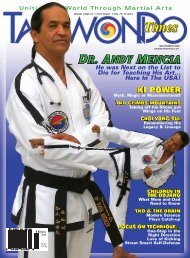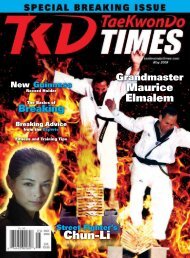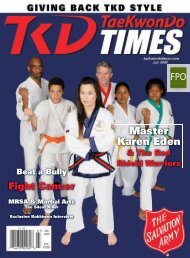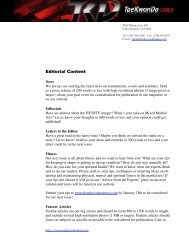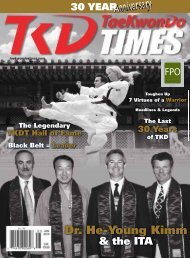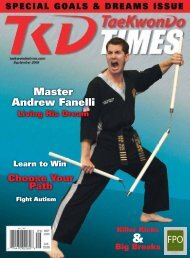Grandmaster Ken MacKenzie - Taekwondo Times
Grandmaster Ken MacKenzie - Taekwondo Times
Grandmaster Ken MacKenzie - Taekwondo Times
You also want an ePaper? Increase the reach of your titles
YUMPU automatically turns print PDFs into web optimized ePapers that Google loves.
The Supplement<br />
We all have a myriad of reasons for getting involved<br />
in martial arts. One goal many of us share is to<br />
lose weight and achieve a greater level of fitness. It is<br />
relatively easy to monitor weight loss by simply using<br />
a bathroom scale or paying attention to the way your<br />
jeans fit. On the other hand, fitness requires more effort<br />
to measure.<br />
Because martial arts training is typically medium<br />
to high intensity and lasts for at least an hour in most<br />
cases, it burns a maximum number of calories per<br />
workout and is therefore great for anyone who wants<br />
to lose weight fast. The average number of calories<br />
burned while participating in an hour-long martial<br />
arts class is approximately 700 calories per hour for<br />
a 155 pound person. (Of course, this depends on the<br />
form of martial arts that you practice and the intensity<br />
of the workout, but this is an average number). This<br />
compares to a 150 pound person running six miles per<br />
hour (a ten-minute mile) for one hour.<br />
However, a person’s weight is not necessarily an<br />
indication of fitness level. Many people equate thinness<br />
with being fit and conversely, overweight with<br />
being out of shape. You can be overweight and still<br />
be relatively fit. But it depends on whether the extra<br />
weight you carry is muscle or fat. Even thin people are<br />
at increased risk of heart disease if they are not active.<br />
So, how can you determine just how fit you are?<br />
The intensity at which you exercise reflects the<br />
amount of oxygen your body uses to do an exercise<br />
and the number of calories you burn while doing it.<br />
Consider these simple strategies for monitoring how<br />
hard you’re exercising and getting the most out of<br />
your workouts. The quick and easy method is the “talk<br />
test” and the more scientific method is “target heart<br />
rate.” As a general rule, moderate-intensity activity is<br />
best. If you exercise too lightly, you may not meet your<br />
fitness or weight loss goals, but if you push yourself<br />
too hard, you may increase your risk of soreness,<br />
injury and burnout.<br />
The talk test is a fast and easy method<br />
used for measuring exercise intensity. By<br />
judging your ability to talk during your<br />
workout, you can determine how hard you’re<br />
working. If you can carry on a conversation<br />
of brief sentences but you cannot sing a<br />
song, you’re probably exercising in the<br />
recommended moderate-intensity<br />
range. If you get out of breath<br />
quickly, you’re probably<br />
working too hard, especially<br />
if you have to stop and catch<br />
your breath. Experts generally<br />
suggest that you should not be<br />
breathless during your workouts.<br />
<br />
However, if you’re doing interval training or a short,<br />
high intensity workout, being somewhat breathless is<br />
okay. Obviously, if you feel dizzy or lightheaded, you<br />
should slow down or stop exercising.<br />
If you want hard numbers then determining your target<br />
heart rate and measuring your pulse is the way to go.<br />
The harder you exercise, the faster your heart pumps.<br />
As you get fitter and as your heart gets stronger, harder<br />
bouts of exercise become easier, so your heart rate may<br />
not be as high doing the same workout once you have<br />
trained to do it. Target heart rates let you measure your<br />
initial fitness level and monitor your progress in a fitness<br />
program. This approach requires measuring your pulse<br />
periodically as you exercise. To measure your pulse, stop<br />
your exercise, place two fingers on the thumb side of<br />
your wrist, or place your index and third fingers on your<br />
neck to the side of your windpipe. When you feel your<br />
pulse, look at your watch and count the number of beats<br />
in 15 seconds. Multiply this number by 4 to get your<br />
heart rate per minute.<br />
Your maximum heart rate is about 220 minus your<br />
age. The table shows estimated target heart rates for<br />
different ages. Look for the age category nearest yours<br />
and read across to find your target heart rate. When<br />
starting an exercise program, aim at the lowest part of<br />
your target zone (50 percent) during the first few weeks<br />
and gradually build up to the higher part of your target<br />
zone (75 percent). After six months or more of regular<br />
exercise, you may be able to exercise comfortably at up<br />
to 85 percent of your maximum heart rate. However,<br />
you don’t have to exercise that hard to stay in shape.<br />
Suzanne Ellenberger holds the rank of EE dan in Choi Kwang<br />
Do martial arts. She works at Clemson University in South<br />
Carolina, where she teaches both freshman chemistry courses<br />
and a class in Choi Kwang Do martial arts. Suzanne also leads<br />
the Clemson University Choi Kwang Do Club.<br />
Average Maximum<br />
Heart Rate<br />
100 %<br />
Target HR Zone<br />
Age<br />
50–85 %<br />
20 years 100–170 beats per minute 200 beats per minute<br />
25 years 98–166 beats per minute 195 beats per minute<br />
30 years 95–162 beats per minute 190 beats per minute<br />
35 years 93–157 beats per minute 185 beats per minute<br />
40 years 90–153 beats per minute 180 beats per minute<br />
45 years 88–149 beats per minute 175 beats per minute<br />
50 years 85–145 beats per minute 170 beats per minute<br />
55 years 83–140 beats per minute 165 beats per minute<br />
60 years 80–136 beats per minute 160 beats per minute<br />
65 years 78–132 beats per minute 155 beats per minute<br />
70 years 75–128 beats per minute 150 beats per minute<br />
84 November 2009 / taekwondotimes.com<br />
By Suzanne R. Ellenberger, Ph.D



